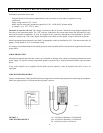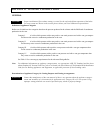
29
Support of Vent Stack
The weight of the vent stack or chimney must not rest on the boiler vent connection. Support must be provided in compliance
with applicable codes. The vent should also be supported to maintain proper clearances from combustible materials.
Use insulated vent pipe spacers where the vent passes through combustible roofs and walls.
Vent Terminal Location
NOTICE: During winter months check the vent cap and make sure no blockage occurs from build up of snow.
Condensate can freeze on the vent cap. Frozen condensate on the vent cap can result in a blocked flue
condition.
Give special attention to the location of the vent termination to avoid possibility of property damage or personal injury.
a) Gases may form a white vapor plume in winter. The plume could obstruct a window view if the termination is installed in close
proximity to windows.
b) Prevailing winds could cause freezing of condensate and water/ice buildup on building, plants or roof.
c) The bottom of the vent terminal and the air intake shall be located at least 12 inches above grade, including normal snow line.
d) Un-insulated single-wall metal vent pipe shall not be used outdoors on cold climates for venting gas utilization equipment.
e) Through-the-wall vents for Category II and IV appliances and non-categorized condensing appliances shall not terminate
over public walkways or over an area where condensate or vapor could create a nuisance or hazard or could be detrimental
to the operation of regulators, relief valves, or other equipment. Where local experience indicates that condensate is a
problem with Category I and III appliances, this provision shall also apply.
f) Locate and guard vent termination to prevent accidental contact by people and pets.
g) DO NOT terminate vent in window well, stairwell, alcove, courtyard or other recessed area, unless previously approved by
local authority.
h) DO NOT terminate above any door, window, or gravity air intake. Condensate can freeze causing ice formations.
i) Locate or guard vent to prevent condensate from damaging exterior finishes. Use a 2' x 2' rust resistant sheet metal backing
plate against brick or masonry surfaces.
j) DO NOT extend exposed vent pipe outside of building. Condensate could freeze and block vent pipe.
k) Multiple direct vent installations require a four (4) foot clearance between the vent caps, center to center.
U.S. Installations- Refer to latest edition of the National Fuel Gas Code.
Vent termination requirements are as follows:
a) Vent must terminate at least four (4) feet below, four (4) feet horizontally, or one (1) foot above any door, window or gravity
air inlet to the building.
b) The vent must not be less than seven (7) feet above grade when located adjacent to public walkways.
c) Terminate vent at least three (3) feet above any forced air inlet located within ten (10) feet.
d) Vent must terminate at least four (4) feet horizontally, and in no case above or below unless four (4) feet horizontal distance
is maintained, from electric meters, gas meters, regulators, and relief equipment.
e) Terminate vent at least six (6) feet away from adjacent walls.
f) DO NOT terminate vent closer than five (5) feet below roof overhang.
Canada Installations- Refer to the latest edition of CAN/CGA-B149.1 and B149.2
A vent shall not terminate:
a) Directly above a paved sidewalk or driveway which is located between two single family dwellings and serves both dwell-
ings.
b) Less than 7 ft. (2.13m) above a paved sidewalk or paved driveway located on public property.
c) Within 6 ft. (1.8m) of a mechanical air supply inlet to any building.
d) Above a meter/regulator assembly within 3 ft. (900mm) horizontally of the vertical center-line of the regulator.
e) Within 6 ft. (1.8m) if any gas service regulator vent outlet.
f) Less than 1 ft. (300mm) above grade level.
g) Within 3 ft (1m) of a window or door which can be opened in any building, any non-mechanical air supply inlet to any
building to the combustion air inlet of any other appliance.
h) Underneath a verandah, porch or deck, unless:
(i) the verandah, porch or deck is fully open on a minimum of two sides beneath the floor, and
(ii) the distance between the top of the vent termination and the underside of the verandah, porch or deck is greater than 1 ft
(30cm)


















